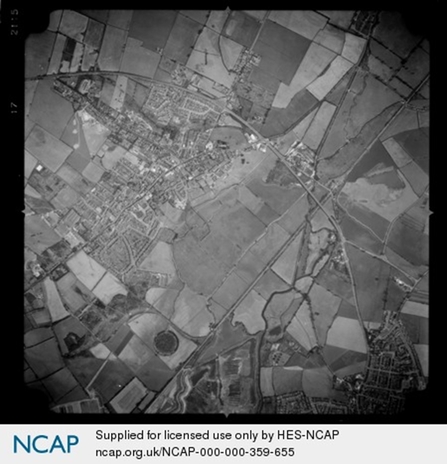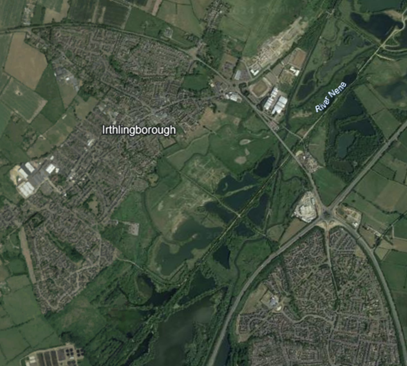
NCAP
Irthlingborough in 19761

NCAP
Irthlingborough in 19761

Google Maps
Irthlingborough today2. More houses, roads, trees and lakes have changed the landscape for people, and for wildlife.
Looking over the River Nene from the edge of Irthlingborough town, an impressive landscape is before you, and one full of history. Depending on when in history you look over the valley, you may spot giant grazers like Aurochs (a large ancestor of modern cattle), or perhaps ‘yrthlings’, small birds such as wrens, wagtails or lapwings that may once have given their name to the town3. A couple of thousand years ago, you might see a young Roman boy dressed in expensive clothes playing along the banks of the river, perhaps a resident of the fine villa that will one day be home to an electricity sub-station. Hundreds of years ago, the river moved freely throughout the valley, keeping the vegetation low and open, making crossing the valley extremely difficult. Lantern towers aided ferries to pass through the misty waters from Irthlingborough to Higham – the expanse far too wide and wet to install a bridge. During this time, you might then see distant lights, and hear shouts from unseen boats bringing cargo and people closer. Many thousands of years ago, as the last ice age receded, you would see a torrent of meltwater and ice, scouring the rocks into the gravel so prized in more modern times. And even just fifty years ago, there were fewer trees, fewer houses, fewer lakes and fewer roads.
The fascinating history of the Nene Valley is a little disorienting when bits are selected at random and squeezed into a paragraph. The change has been going on for a very long time, and most of it is forgotten. Some we notice when it happens, such as the building of a ski slope or a shopping centre, and some sneaks up on us and might go unnoticed, like the slow change from open ground to wooded areas, or the loss of a particular species of bird. But one thing is certain – change is inevitable.
Arguably the biggest change in human history is just beginning. February marked the wettest 18 months on record4 – that’s a year and a half of the wettest weather in 140 years. The Nene experienced its highest flow since 19704 in February, meaning parts of the nature reserve including many paths were inundated and significantly damaged. Climate change is predicted to bring more extreme rainfall in winter, and more extreme heat and drought in summer. The sad fact is that climate change is happening now, right on our doorstep, and people and nature will suffer immensely from the impacts5.
Clearly you and I aren’t going to solve this alone, though we might want to. With a General Election imminent, what are the politicians going to do? Unfortunately, the Climate and Biodiversity Crises are not being taken seriously enough by any political party. Half of all global GDP is underpinned by healthy, natural resources – our bank balance relies on nature being there and being healthy. According to four leading nature charities including The Wildlife Trusts, political parties need much more concrete plans for restoring nature6 – as it stands they’re not doing enough to protect nature, and to protect us. Failing to protect our natural resources will negatively impact our economy and our quality of life – so we must vote for nature. We must demand politicians forget the quick buck and play the long game - working to protect nature for future generations.
Whilst political change is needed - you and I must vote to protect nature to protect ourselves - there are things we as conservationists are doing to improve the situation locally. As change is inevitable, our job on Nature Reserves is not to stop change, but to influence change. The more beneficial a place is to wildlife – or the more diverse it is, the more resilient it is to change. The way to get diversity is through careful management – changing things on a small scale to give us the widest range of functional habitats. Previous blogs have discussed the importance of tree works on Nature Reserves, to maximise the value of the habitat for wildlife, to deal with the impacts of disease like Ash Dieback, and to keep paths functional for both people and wildlife. It’s not just trees we manage of course, grasslands and islands and lake edges also get careful management to make them the best they can be for wildlife. This management is constantly monitored and reviewed to make sure the work is still as beneficial as it can be.
Another important way we manage change is to observe how wildlife and people are being impacted over time, and bring in or support changes to manage this. For example, the recently introduced Public Spaces Protection Order6 means dogs must be picked up after and on leads across lots of public spaces across the Nene Valley. By supporting this and informing people of the importance of this, we’re doing something new to benefit the wildlife and the people on our Nature Reserves.
Change always brings some confusion - if you’re reading this and are thinking ‘I feel angry/confused/disappointed/unsure about X’, it must mean you care about our Nature Reserves. So, we’re mostly in agreement – we care deeply about them too. But your anger, confusion, disappointment or uncertainty doesn’t necessarily mean we’re doing it wrong. We carefully consider everything we do, using decades of collective experience and professional judgement to manage a complex, ever changing system. It might look messy, it might go against what you think is right, but we never do it just for the hell of it, or for any other reason than to for wildlife, and for the people who want to appreciate wildlife. Do we always get it right? No! Lots of what we do is an experiment – usually it works, sometimes it doesn’t. Do we always work to make the reserve the best place it can be for wildlife, and for those that want to appreciate it? Absolutely. We simply wouldn’t be here if we didn’t. And for me, part of that is explaining to people what we’re doing and why. If people don’t like it – that’s ok. Other people’s opinions are none of my business. And fortunately, many, many people do like it, and support us to keep these special places the best they can be for wildlife and people.
I once spoke to a woman at Nene Wetlands who told me we were ‘fighting a losing battle’. I don’t think we are, for two reasons. I see positive change on the reserve every day. And I don’t think it’s a battle – we need to ally with each other, and with nature. But either way, we all have to make an individual decision… Do I want to be on the side that didn’t try to make change for the better, or the side that gave it their all?
References
NCAP: Irthlingborough; Irthlingborough CP; Northamptonshire; England https://ncap.org.uk/frame-download/11-1-4-121-11 Higher resolution images are available from NCAP
Copyright Google.
Wikipedia: Irthlingborough https://en.wikipedia.org/wiki/Irthlingborough
Environment Agency: Water Situation, February 2024 Summary https://www.gov.uk/government/publications/water-situation-national-mon…
Met Office: Effects of Climate Change https://www.metoffice.gov.uk/weather/climate-change/effects-of-climate-…
North Northamptonshire Council: Public Spaces Protection Orders https://www.northnorthants.gov.uk/community-safety-and-emergencies/publ…